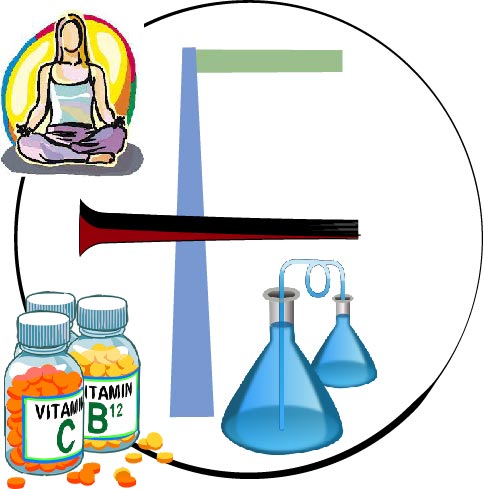HPLC
High Performance Liquid Chromatography (HPLC)
An analytical separation technique that involves the high-pressure
flow of a liquid through a column that contains the stationary phase.
Stationary phase: Can be a solid (LSC) or a liquid (LLC)
A mixture of compounds injected at one end of the column
separates as the compounds pass through.
Separated compounds are detected electronically as they
elute at the other end of the column
Instrumentation
1) Solvent or mobile phase
Major components
Usually a mixture of an organic solvent (Ex. methanol, IPA)
and water
Sometimes buffered – keeps solutes in electrically neutral form
Solvent polarity affects the separation process
Mobile phase considerations
Must be filtered (to prevent tiny solids from depositing at the
column head) and degassed
Degassing is done by helium sparging
Bubbles could interfere with detection
Pump
Role is to pump the solvent at a high pressure (usually from
1000 to 6000 psi) through the packed column
Injector
Sample introduction system
Usually a loop injector – see image below
Introduces the injected sample to the flowing mobile phase
Automated injectors are common
Column
A small metal tube (typically 5 to 30 cm long; 1-5 mm i.d.)
that contains the stationary phase
Instrumentation (Cont.)
Role is to separate the components of a mixture
Column – Cont.
Much shorter than columns used in GC — Why?
Highly efficient separations achieved in HPLC due to
interactions of both m.p. and s.p. with the components of
a mixture
vs. GC, where only the s.p. interacts with
components
No need for long columns
Column Oven:
This allows the separation of individual sample components to be controlled and optimised. Columns come in two types: packed and capillary . Most gas chromatography today is performed using capillary columns, as they offer significant advantages for most samples
Detector
Different design from those of GC detectors because the
components are dissolved in a liquid m.p. (vs. gas in GC)
HPLC Column Selection
Dependent on the:
(1) type of mixture being separated, and
(2) type of interaction with the s.p
HPLC Bolg
Type of HPLC column
by maheshbhuva | Mar 31, 2024 | Analytical Chemistry, Analytical method development hplc,, Hplc, Hplc column, Quality control (QC)
In HPLC chromatography, the column is where the separation of the sample takes place. This is where the sample is passed through the stationary phase with the mobile phase, resulting in the separation of the sample components. As the sample being analyzed is likely to...
621 no chapter chromatography was update at on date 1-dec-2022
by maheshbhuva | Jul 28, 2023 | 621 USP CHAPTER, Analytical Chemistry, Hplc
What is update change Definitions Here Definitions and chromatograms both unified and give title Definitions Give method dwell volume determine being added Definitions add definitions size-exclusion chromatography (Distribution constant, Retention time of an...
Latest pharmacopoeia
by maheshbhuva | Jul 25, 2023 | Analytical Chemistry, Hplc, Pharmaceutical interview,
USP 44-NF 39, which became official on November 1, 2021.
Type of Compartment of HPLC & GC ?
by maheshbhuva | Jul 6, 2023 | Analytical Chemistry, Hplc
HPLC Going into more detail, HPLC consists of a variety of components, including a solvent delivery pump, a degassing unit, a sample injector, a column oven, a detector, and a data processor. GC GC uses an inert or unreactive carrier gas as the mobile phase, and the...
Type of buffer in Hplc
by maheshbhuva | May 18, 2023 | Hplc
Phosphate buffer Citrate buffer Formate buffer Acetate buffer Tris(hydrixymethyl) -aminomethane Phosphate buffer Pka 2.1 Ph range 1.1 tob3. 1 Pka 7.2 Ph range 6.2 to 8.3 Pk 12.3 Ph range 11.3 to 13.3 Citrate Pka 3.1 Ph range 2.1 to 4.1 Pka 4.7 Ph 3.7 to 5.7 Pka 5.4 Ph...
HPLC Calibration As per IPC Pharmacopeia give guidance
by maheshbhuva | Mar 24, 2023 | Hplc
HPLC Calibration we have perform as earlier as per protocol Company will provided Like example Shimanzu HPLC calibration will perform as per that guidance's But now a day In 16th September 2021 As per IPC Pharmacopeia give guidance(Document ID IPC/GD/05) HPLC...
How can read Protocol analyst
by maheshbhuva | Jan 28, 2023 | Analytical Chemistry, Analytical method development hplc,, Hplc
HPLC Analyst ○ Whenever supervisor give work allocation for testing any product. ○ HPLC analyst first seen Test which is Assay by HPLC or RS By HPLC, Chiral test etc ○ Then careful read specification(SOP) not missing any point which is defied in sop ○ Then Seen Which...
How can read Protocol analyst During HPLC analysis and what Is flow ?
by maheshbhuva | Jan 27, 2023 | Analytical Chemistry, Hplc
• HPLC Analyst ○ Whenever supervisor give work allocation for testing any product. ○ HPLC analyst first seen Test which is Assay by HPLC or RS By HPLC, Chiral test etc ○ Then careful read specification(SOP) not missing any point which is defied in sop ○ Then Seen...
Chromatography
by maheshbhuva | Jan 20, 2023 | Analytical Chemistry, Analytical method development hplc,, Hplc
Chromatography
Why does Acetonitrile use in HPLC Method development?
by maheshbhuva | Dec 28, 2022 | Analytical Chemistry, Analytical method development hplc,, Hplc
it is miscible with water, has good eluotropic strength and also low viscosity alone and mixed with water. Acetonitrile high-sensitivity analysis with UV detection in the short-wavelength region. However , organic solvents which have been processed for HPLC IN...


